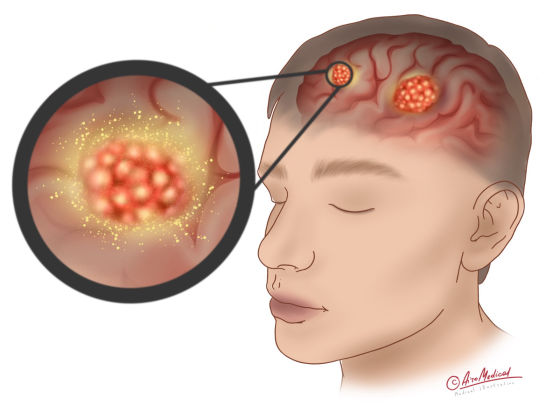Brain Metastases Guide

20-40% of patients with tumors might get a brain or spinal cord metastasis.
Patients with brain metastases who don't receive treatment have an estimated survival rate of 2 months.
In the USA, brain metastases are discovered in 170 000 patients annually.
80% of brain metastases develop in the cerebral hemispheres.
 A few words about the brain
A few words about the brain
The brain is the central nervous system organ involved in most consciousness and unconscious process the human organism performs. It consists of the cerebellum, the brain stem, and the cerebrum. Among the most vital functions of the brain are:
- Processing, coordinating, and integrating sense organs' information.
- Cognition.
- Emotions.
- Movements and motor activity.
- Language.
- Direct or indirect control over other body's organs.
The brain mainly consists of nerve cells (neurons) connected together and includes a few other types of cells. The average number of neurons in the human brain is over 120 billion. It's the most complex and one of the most important human body organs.
Suppose the brain is severely injured due to trauma, neurological disease, cancer, or any other cause. In that case, it might result in disability and even death, which makes the brain one of the most vital organs for all humans.
 What are brain metastases?
What are brain metastases?
Any cancer, especially when it remains untreated, might spread across the human body and form new lesions called metastases. The brain is not an exception. Cancer cells mostly migrate through blood vessels and lymphatic vessels or directly from a primary tumor to the surrounding organs and tissues. Clinicians talk about metastatic brain cancer when those cells reach the brain and create lesions.
 It's important to understand that a primary brain tumor isn't the same as metastatic brain cancer. Mainly due to differences in diagnostic approach, treatment, and prognosis. Naturally, the further management of patients with metastatic brain tumors is strongly related to primary cancer localization and state. Also, some cancer types are more likely to cause brain metastases.
It's important to understand that a primary brain tumor isn't the same as metastatic brain cancer. Mainly due to differences in diagnostic approach, treatment, and prognosis. Naturally, the further management of patients with metastatic brain tumors is strongly related to primary cancer localization and state. Also, some cancer types are more likely to cause brain metastases.
Among them are:
- Lung cancer (50%)
- Breast cancer (15-20%)
- Melanoma (5-15%)
- Kidney cancer (7%)
- Colon cancer (4-6%)
As you can see, the most significant probability of metastatic brain cancer is related to organs that remain in the chest area. It happens because those organs' metastatic cells must pass a small distance via lymphatic vessels to reach the brain. This is one of the main reasons breast and lung cancer remain among the most common causes of metastatic brain cancer.
However, in the case of melanoma, colon, and kidney cancer, brain metastases mostly reach their destination point via blood vessels which is a more complicated and prolonged process. Also, those types of cancer are more likely to cause metastases at first in organs located near the primary tumor and only after that spread further.
Most often, the verification of metastatic brain cancer happens when multiple lesions are formed. Unfortunately, only 10% of patients get the brain metastases diagnosis when there is a single lesion. This creates additional complications during the treatment process and sets extra importance for regular full-body screening.
 Brain metastases risk factors
Brain metastases risk factors
The probability and speed of brain metastases' development are strongly related to the type of primary cancer. For example, patients with non-small-cell lung cancer have a higher chance of developing metastatic brain cancer if the primary tumor's diameter is >5.050 cm. In comparison, patients with HER2-positive breast cancer have increased chances of developing brain metastases if their tumor is >2 cm. Still, there are some shared risk factors for brain metastases development, regardless of localization and type of primary cancer.
They are:
- Pure treatment or untreated primary tumor. Less than 10% of patients who got surgery in the early stages of cancer showed a 5-year tendency to develop brain metastases.
- Late diagnosis. About 44% of patients with III- and IV-stage freshly verified melanoma already developed brain metastases.
- Missed screening. This is especially crucial for all patients whose cancer was successfully treated in the past five years.
- Family history. Patients who got close relatives with a history of metastasis brain tumors tend to show more tendency to develop cancer in the brain.
Certain ages also could significantly increase the probability of brain metastases development. Still, this risk factor is also strongly related to the localization of the primary tumor and histological type. For example, patients with primary lung cancer have a higher probability of developing brain metastases at age 40-49, while those diagnosed with melanoma got increased changes at age 50-59.
How to prevent brain metastases?
Prevention of brain metastases is more or less similar to prevention in any area of the human body, regardless of the primary cancer type. In addition, most prevention methods are strongly related to future treatment and screening procedures. Among the essential strategies to prevent brain metastases are:
- Early primary cancer diagnosis verification. Brain metastases might be prevented more successfully if the patient got their cancer diagnosis verification early.
- Sticking to the chosen treatment. Naturally, patients will develop brain metastases faster and with more probability if they wouldn't get treatment in a proper volume and according to the plan.
- Take regular screenings after successful treatment. CT and blood screening tests are necessary to ensure the patient doesn't relapse or develop brain metastases.
- Prophylactic cranial irradiation (PCI). This method is primarily used in highly aggressive cancer cases and involves radiotherapy in combination with various systematic chemotherapy medications. It shows a 50% reduction in the development of brain metastases in patients with small-cell lung cancer.
Prevention and treatment of brain metastases are also related to primary cancer prevention. Therefore, it's essential to stick to general rules of well-being and general management of cancer prevention to avoid the development of metastatic brain cancer. Among them are avoiding smoking, having a sufficient diet, developing a healthy lifestyle, etc.
 Brain metastases symptoms
Brain metastases symptoms
As the human brain is a highly complex organ that controls all organism's functions and other organs of the human body, a potential list of brain metastasis symptoms might be very long. Mostly, they are related to the localization of lesions in the brain. Still, some symptoms are much more common and can be found in up to 60-75% of patients with metastatic brain cancer.
Among them are:
- Fatigue (~75%)
- Headaches (40-50%)
- Seizures (15-20%)
- Vomiting or nausea
- Memory loss
- Numbness of weakness in body parts
- Behavioral or emotional changes
It's essential to remember that, in some cases, patients with brain metastases remain asymptomatic for a long time. That's why it's necessary to undergo full-body screening tests for all patients with cancer, even if they don't show any of the brain metastasis symptoms. Also, screenings and full-body scanning are recommended for all patients who successfully overcome cancer to prevent relapses.
 How to verify brain metastases diagnosis?
How to verify brain metastases diagnosis?
About 30% of brain metastases are discovered by doctors while verifying primary tumor diagnosis. Still, due to the specific localization of lesions, it's not always easy to detect and verify them. For example, about 80% of patients can't get a biopsy and undergo surgical treatment due to possible significant harm from side effects.
That's why among the most popular tests to verify brain metastases are:
- Contrast Enchanse MRI (CEMRI). This method is known as a "golden standard" in differential diagnostics of non-neoplastic lesions and tumors in the brain. During the procedure, the patient receives intravenous contrast (most often, gadolinium) and undergoes an MRI.
- MR spectroscopy. This method allows doctors to suspect brain metastases by analyzing the concentration and presence of certain chemical substances in the tissues. MR spectroscopy might be very useful in differential diagnostics of metastatic brain cancer with non-cancer-related lesions in the brain, primarily when CEMRI can't be performed.
- Computer tomography (CT). This method is mainly used when MRI can't be performed due to contraindications (e.g., previously installed pacemaker). In addition, computer tomography is often combined with MR spectroscopy to distinguish brain metastases and other lesions.
- Positron emission tomography (PET). PET is not considered a method of choice to verify brain metastases. They usually become sudden findings. The average PET sensitivity of brain metastatic cancer detection is around 27%. Still, this method is widely used and essential to set a proper diagnosis and stage of primary cancer.
Biopsy as a method of brain metastases diagnosis verification remains one of the methods with almost 100% accuracy. Still, due to the specific nature of brain anatomy and procedure requirements, in most cases, it's more effective to perform a surgical treatment with further examination of removed tissues than only a biopsy.
In some instances, brain metastases might not be big enough for MRI and CT to detect them. For example, MRI fails to detect metastatic brain cancer lesions smaller than 1 mm. That's why it's essential to undergo regular screenings and scanning procedures in reliable clinics to prevent metastatic brain cancer relapses.
Metastatic brain cancer is a severe complication of the primary disease, and developing an adequate treatment plan often requires a consensus of a vast number of specialists. Moreover, involving more medical practitioners might often open new treatment opportunities and create better chances for patients with metastatic brain cancer to have a healthy and long life.
That's why it's always essential to get a second opinion from oncologists and neurosurgeons in case of brain metastases. Therefore, AiroMedical will gladly help all patients with metastatic brain cancer to get a second opinion from the best medical practitioners worldwide.
Countries with the most advanced brain metastases treatment
 Conventional treatment of brain metastases
Conventional treatment of brain metastases
Any treatment for brain metastases must be performed along with treating a primary tumor and cancer lesions in other organs. In other cases, the efficiency of any therapeutic management will remain very low. Among the treatment methods that are the most suitable for patients with brain metastases are:
Surgery. This treatment method shows excellent results in improving cognitive and neurological symptoms. But unfortunately, only 50% of patients with a single lesion are applicable for surgical treatment of brain metastases. Furthermore, as the number of lesions in the brain increases, the number of patients who can successfully undergo surgical treatment decreases significantly.
- Craniotomy. This method of brain metastases treatment involves removing a part of the skull to access the brain. As a result, surgeons get a clear view of all metastatic brain cancer lesions, but this surgery tends to be associated with higher patient risks.
- Neuro endoscopy. When metastatic brain cancer is treated with neuro endoscopy technology, only a tiny hole in the patient's skull is required to insert the camera and instruments. As a result, patient risks decrease, but doctors might miss the brain metastases during the surgery.
Stereotactic radiosurgery (SRS). One of the most advanced treatments technics uses focused and precisely directed radiation beams, allowing opportunities to avoid unnecessary harm to surrounding healthy tissues. Nowadays, Gamma Knife remains one of the most widely used methods.
Whole brain radiotherapy (WBRT). This method is traditionally used among patients who successfully underwent surgical treatment and as a method that can potentially boost the efficiency of chemotherapy. Usually, WBRT is used for patients with multiple (>5) metastatic lesions, and it tends to show significant side effects compared to SRS.
Chemotherapy. This method involves using various intravenous infusions of cytotoxic drugs. The efficiency of chemotherapy for patients with brain metastases is mainly related to the primary tumor's sensitivity and might vary. For example, the best response rates could be seen among patients with primary small-cell lung cancer (30-80%), while patients with primary melanoma tend to show the worst treatment response rate (10-15%).
Immunotherapy. Immunotherapy uses various chemical substances to activate a patient's immune system and improve its ability to destroy cancer cells. In some instances, it might be more effective in treating brain metastases than chemotherapy. For example, melanoma-related brain metastases showed a 57% treatment response rate when patients got immunotherapy.
Target therapy. During target therapy, patients take chemical substances that suppress the further growth of cancer by interacting with specific molecules, which are necessary for further tumor growth.
Among the most effective treatment tactics for patients with metastatic brain cancer is so-called combined therapy. This method involves simultaneously using a few ways of treatment to prevent disease relapse or achieve the best possible treatment results. Unfortunately, combined therapy is often associated with more severe side effects, so its components must be chosen wisely.
What are the best hospitals to treat brain metastases?
 New treatment for brain metastases
New treatment for brain metastases
One of the most problematic aspects preventing the effective treatment of brain metastases is the so-called blood-brain barrier (BBB). This essential feature of the nervous system prevents various chemical substances, infectious agents, and other potentially harmful agents from entering the brain from the blood. Unfortunately, BBB also often creates an obstacle for drugs. As a result, many of them tend to be less effective than possible.
Drug-BBB transport conjugates were created to overcome the ability of BBB to prevent drugs from reaching brain metastases in sufficient amounts. They form a complex with drug molecules that help them pass the blood-brain barrier and reach metastatic lesions in adequate quantities.
Another one, highly effective method of drug delivery in case of brain metastases is various nanomedicines. Currently, 51 components have been clinically approved and widely used to treat multiple diseases. Moreover, most nanomedicines also significantly reduce toxic effects on healthy tissues and improve drugs' main effects.
Another essential innovative method that helps to improve treatment is MRI-guided, focused ultrasound (MRgFUS). MRgFUS helps enhance drug delivery and tends to be especially effective as a part of chemotherapy with nanomedicines.
Also, lots of treatment methods for metastatic brain cancer considering new and are not widely available. This fact is mainly related to a lack of specific qualifications among medical practitioners, apparatuses, and medical supplements. Still, as time passes, more and more clinics and hospitals make them available for patients with brain metastases.
Among those methods are:
- MRI-guided stereotactic laser ablation (MRgLITT). During this procedure, the optic fiber inserts into the patient's skull and deliver laser energy to destroy metastatic brain cancer lesions. To ensure that optic fiber reaches the brain metastases, doctors use MRI. This method is mainly used for treatment in only a few (1-3) brain metastases developed, and in 80,6% of cases, the volume of metastatic brain cancer lesions was decreased.
- Treatment with alternating electric fields (Optune). This method uses apparatus that generates electrical impulses and sends them via electrodes placed on the patient's skull to treat metastatic brain cancer. Patients need to stay connected to Optune for at least 18 hours daily for better results.
- Brachytherapy. A small sealed radiation source inserts in tissues near metastatic brain cancer lesions. In many cases, this method is associated with an increased risk of side effects.
- Proton therapy. This method involves a proton beam that delivers ionization energy to brain metastases. Proton therapy helps to decrease potential adverse effects that occur during traditional radiotherapy or even radiosurgery, such as Gamma Knife treatment for brain metastases. For example, the average presence and severity of toxical effects after using proton therapy are 35% fewer than traditional radiation therapy.
- Dendritic cell-based cancer vaccine. This is a newly developed method of immunotherapy that helps to activate the human immune system to destroy brain metastases and primary tumors. Cancer vaccines are more beneficial against aggressive types of cancer.
- Tumor-infiltrating lymphocytes therapy (TIL). Lymphocytes are immune cells that help to fight infections, cancer, and other diseases. Studies show that extracting those cells with further enchanting and reinserting them back into the human body shows decent results in treating metastatic brain cancer.
- CAR T-cell therapy. To help the immune cells to find and destroy metastatic brain cancer lesions more effectively, doctors took t-cells from the patient's blood and added a specific gene to their structure. After that, those t-cells are given back to patients.
Besides that, nowadays, doctors and scientists have developed various alternative treatment methods for metastatic brain cancer. However, most of those methods still undergo clinical trials and are about to be released to the public soon. Still, some patients with metastatic brain cancer might enroll to participate in those trials. Therefore, AiroMedical will gladly help you to find opportunities to join the developing treatment programs for patients with brain metastases.
What are the best doctors helping to manage brain metastases?
 Stats and life expectancy for patients with brain metastases
Stats and life expectancy for patients with brain metastases
Unfortunately, nowadays, metastatic brain cancer tends to be associated with a very high mortality rate. For patients with brain metastases, life expectancy without treatment remains very short, which creates significant importance to seeking medical advice and starting treatment as soon as possible. Besides that, only a proper treatment plan can help you to prevent relapses and get rid of metastatic brain cancer forever.
Life expectancy is strongly related to primary cancer localization, treatment options, and the number of metastatic lesions in the brain. In any case, for patients with brain metastases, life expectancy with treatment is at least a few times longer compared to no treatment. As radiation therapy is nowadays the method of choice for patients with brain metastases, we created a graph that showcases the average life expectancy for patients who used different methods of radiation therapy.
It's important to remember that many patients are also eligible for other treatment options. In some instances, life expectancy with treatment might be extended up to a few decades for patients with brain metastases. A wide range of specialists should analyze each case of metastatic brain cancer very carefully to develop the most effective treatment plan. That's why it's always important to seek a second opinion and be aware of as many treatment options as possible.
The AiroMedical team will gladly help you to choose the best treatment plans, doctors, and hospitals and help to improve your quality of life significantly. We carefully evaluate each case to understand all potentially suitable treatment options available worldwide and choose the best treatment plans based on scientifically-based data and official statistics.
References:
- Monteiro C, Miarka L, Perea-García M, et al. Stratification of radiosensitive brain metastases based on an actionable S100A9/RAGE resistance mechanism. Nat Med. 2022;28(4):752-765. doi:10.1038/s41591-022-01749-8
- Hao P, Chen L, Ge Y, You Y, Yan G, Jin ZW. Time taken for a primary tumor to metastasize to the brain and the overall survival of patients with brain metastasis: An analysis of outcomes and factors affecting survival. Technol Health Care. 2022;30(S1):259-270. doi:10.3233/THC-228025
- Barnholtz-Sloan JS, Sloan AE, Davis FG, Vigneau FD, Lai P, Sawaya RE. Incidence proportions of brain metastases in patients diagnosed (1973 to 2001) in the Metropolitan Detroit Cancer Surveillance System. J Clin Oncol. 2004;22(14):2865-2872. doi:10.1200/JCO.2004.12.149
- Bovi JA. Prevention of Brain Metastases. Front Neurol. 2018;9:758. Published 2018 Sep 28. doi:10.3389/fneur.2018.00758
- Mitchell DK, Kwon HJ, Kubica PA, Huff WX, O'Regan R, Dey M. Brain metastases: An update on the multi-disciplinary approach of clinical management. Neurochirurgie. 2022;68(1):69-85. doi:10.1016/j.neuchi.2021.04.001
- Bertolini F, Spallanzani A, Fontana A, Depenni R, Luppi G. Brain metastases: an overview. CNS Oncol. 2015;4(1):37-46. doi:10.2217/cns.14.51
- Soffietti R, Abacioglu U, Baumert B, et al. Diagnosis and treatment of brain metastases from solid tumors: guidelines from the European Association of Neuro-Oncology (EANO). Neuro Oncol. 2017;19(2):162-174. doi:10.1093/neuonc/now241
- Tawbi HA, Forsyth PA, Algazi A, et al. Combined Nivolumab and Ipilimumab in Melanoma Metastatic to the Brain. N Engl J Med. 2018;379(8):722-730. doi:10.1056/NEJMoa1805453
- Lim M, Puttick S, Houston ZH, et al. Innovative Therapeutic Strategies for Effective Treatment of Brain Metastases. Int J Mol Sci. 2019;20(6):1280. Published 2019 Mar 14. doi:10.3390/ijms20061280
- Park, K., Bae, G.H., Kim, W.K. et al. Radiotherapy for brain metastasis and long-term survival. Sci Rep 11, 8046 (2021). https://doi.org/10.1038/s41598-021-87357-x

















